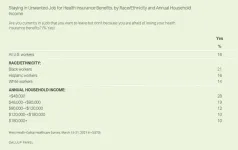(Press-News.org) (MAY 6, 2021) New York, NY - With around 30 percent of the U.S. population now fully vaccinated, the rate of daily vaccinations has started to slow, raising concerns that greater efforts and investments may be needed to reach higher coverage levels. A study published in the Journal of Infectious Diseases on May 6 shows the lives, hospitalizations, and costs that can be saved by even relatively small increases in vaccination coverage and reaching higher vaccination coverage levels sooner (e.g., by the end of the summer versus fall/winter).
The study was led by researchers from PHICOR (Public Health Informatics, Computational, and Operations Research) at CUNY Graduate School of Public Health & Health Policy, the National School of Tropical Medicine at Baylor College of Medicine, and Johns Hopkins Center for Health Security. The team developed a computer simulation model of the entire U.S. and the spread of the COVID-19 coronavirus throughout the country. Using the model, the team could simulate vaccinating different proportions of the population at different rates with different types of COVID-19 vaccines. Like real people, each of these virtual people could become infected with the virus and develop different symptoms over time and, depending upon the severity of those symptoms, visit clinics, emergency departments, or hospitals. These in turn would have associated costs, allowing the tracking of various medical costs and productivity losses.
The study showed that going from a 30 percent vaccination coverage to a 40 percent coverage could save 24.3 million cases and $33.1 billion in direct medical costs and productivity losses. Going from a 50 percent to 70 percent coverage could save 9.5 million cases and 10.8 billion in direct medical costs and productivity losses.
In fact, even relatively small increases in vaccine coverage can prevent thousands of cases and lives and hundreds of millions in costs. For example, results from the model showed each 1 percent increase between 40 and 50 percent of the U.S. population being vaccinated by the fall can prevent 1.6 million cases, 60,190 hospitalizations, and 7,100 deaths and save $674.2 million in direct medical costs and $1.5 billion in productivity losses. Each 1 percent increase between 50 and 70 percent can prevent 473,900 cases, 17,600 hospitalizations, 2,000 deaths, and 537 million in direct medical costs and productivity losses.
The study also emphasized the importance of reaching higher coverage levels as soon as possible. For example, speeding up vaccinations to reach a 50 percent coverage by July 2021 instead of October 2021 could save an additional 5.8 million cases, 215,790 hospitalizations, 26,370 deaths, $3.5 billion in direct medical costs, and $4.3 billion in productivity losses.
Results suggested that getting as many people fully vaccinated as possible before the early winter would be particularly important. The model incorporated changes in the transmission of the virus that occurred with the changing seasons in 2020, when surges occurred during the winter months, and projected what may happen in 2021. For example, when 50 percent of the U.S. population is vaccinated by October 2021 instead of the end of December 2021, 6.6 million cases, 252,260 hospitalizations, 29,380 deaths, $4.0 billion direct medical costs, and $8.0 billion productivity losses were saved.
"The results of this study can give policymakers, community leaders, and other decision makers a sense of how much can be invested into vaccinating those who may be harder to get vaccinated," explained Sarah Bartsch, MPH, the study's lead author and project director for PHICOR. "Such investments may end up paying for themselves. For example, the potential cost savings exceed the $1.5 billion Biden Administration community outreach and media campaign. Our results show that increasing total vaccination coverage by just one percent could cover the costs of this effort."
"The longer it takes to reach higher vaccination coverage levels and herd immunity thresholds, the more the virus can spread," said Bruce Y Lee, senior author of the study, executive director of PHICOR, and CUNY SPH professor. "It may be particularly important to reach higher coverage levels before the late fall to prevent another winter surge."
Additionally, the study showed how increasing vaccination coverage levels was more valuable than using vaccines with higher effectiveness. For example, we found that achieving a 70 percent coverage with a 70 percent effective vaccine can save 2.1 million cases and 5.5 billion in medical costs and productivity losses compared to achieving a 50 percent coverage with a 90 percent effective vaccine over the same period. This shows the value of using all Covid-19 vaccines that are available to get more people vaccinated as soon as possible, rather than focusing only on those with the highest effectiveness. Moreover, as more contagious variants circulate, potentially decreasing the effectiveness of the existing Covid-19 vaccines, this can help address concerns about continuing with the existing vaccines or waiting for an updated version.
INFORMATION:
Media contact:
Sarah Rebbert
Sarah.Rebbert18@gmail.com
About CUNY SPH
The CUNY Graduate School of Public Health and Health Policy is committed to teaching, research, and service that creates a healthier New York City and helps promote equitable, efficient, and evidence-based solutions to pressing health problems facing cities around the world. Follow @CUNYSPH for updates.
About PHICOR
Since 2007, PHICOR has been developing computational methods, models, and tools to help decision makers better understand and address complex systems in health and public health. Follow @PHICORTeam for updates.
Philadelphia, May 6, 2021 - Misunderstanding food date labeling is common and educational communications are needed to improve consumer understanding, according to a new study in the Journal of Nutrition Education and Behavior, published by Elsevier.
Does it mean "spoiled - throw it out," or "might not taste as good as it could anymore?" Food date labels (e.g., "USE By August 16") can play an important role in helping consumers make informed decisions about food, and ultimately prevent unsafe consumption and waste of food. Researchers surveyed 2,607 adults in the United States to assess consumer understanding of the streamlined 2-date ...
PULLMAN, Wash. -- With state legislatures nationwide preparing for the once-a-decade redrawing of voting districts, a research team has developed a better computational method to help identify improper gerrymandering designed to favor specific candidates or political parties.
In an article in the Harvard Data Science Review, the researchers describe the improved mathematical methodology of an open source tool called GerryChain. The tool can help observers detect gerrymandering in a voting district plan by creating a pool, or ensemble, of alternate maps that also meet legal voting criteria. This map ensemble can show ...
The identity of the skeletal remains of a member of the 1845 Franklin expedition has been confirmed using DNA and genealogical analyses by a team of researchers from the University of Waterloo, Lakehead University, and Trent University. This is the first member of the ill-fated expedition to be positively identified through DNA.
DNA extracted from tooth and bone samples recovered in 2013 were confirmed to be the remains of Warrant Officer John Gregory, engineer aboard HMS Erebus. The results matched a DNA sample obtained from a direct descendant of Gregory.
The remains of the officer were found on King William Island, Nunavut. "We now know that John Gregory was one of three expedition personnel who ...
A team of engineers recommends expanding fast-charging stations for electric vehicles as campuses and businesses start planning for a post-pandemic world.
The recommendation is based on a study of charging patterns for electric vehicles on the University of California San Diego campus from early January to late May of 2020, after the university moved most of its operations online. Researchers say the findings can be applied to a broader range of settings.
"Workplace charging is a critical enabler of carbon-free transportation as the electrons consumed primarily come from solar power plants, as opposed to at-home charging, which occurs at night and relies more on fossil ...
WASHINGTON, DC - MAY 6, 2021 - One out of every six adult workers (16%) in the United States are staying in jobs they might otherwise leave out of fear of losing their employer-sponsored health insurance, according to a new West Health-Gallup survey of more than 3,800 U.S. adults.
The survey finds the fear is even more pronounced among Black workers, who are 50% more likely to remain in an unwanted job than their White and Hispanic counterparts (21% to 14% and 16%, respectively).
But the most likely to stay in a job they would rather leave are those workers in households earning less than $48,000 a year -- roughly 3 in 10 (28%) say they will not leave and risk losing their health benefits. Workers in lower income households are nearly ...
Sophia Antipolis, 6 May 2021: One in four heart attack patients have atypical symptoms such as breathing difficulties, extreme exhaustion, and abdominal pain, according to a study published today in European Heart Journal - Acute Cardiovascular Care, a journal of the European Society of Cardiology (ESC).1 Patients with atypical symptoms were less likely to receive emergency help and more likely to die within 30 days compared to those with chest pain.
"We found that atypical symptoms were most common among older people, especially women, who called a non-emergency helpline for assistance," said study author Ms. Amalie Lykkemark Møller, PhD student, Nordsjællands Hospital, ...
A large study from Denmark and Norway published by The BMJ today sheds more light on the risk of rare blood clots in adults receiving their first dose of the Oxford-AstraZeneca covid-19 vaccine.
The findings show slightly increased rates of vein blood clots including clots in the veins of the brain, compared with expected rates in the general population. However, the researchers stress that the risk of such adverse events is considered low.
Cases of rare blood clots in people who have recently received their first dose of the Oxford-AstraZeneca covid-19 vaccine have been reported. Whether these cases represent excess events above expected ...
The new Danish-Norwegian study is the first study to document possible adverse events in relation to the COVID-19 vaccine Vaxzevria? from AstraZeneca, in which all vaccine recipients have been followed systematically, as opposed to previous studies, which have relied primarily on reported adverse reactions.
The new study was a cooperation between Danish and Norwegian research institutions.
- In this study, we were able to identify all hospital contacts among vaccinated persons by utilising the unique Danish and Norwegian health registers. This ensures that we get a comprehensive of the rate of adverse reactions. ...
Some clinicians are concerned that post-traumatic stress disorder (PTSD) diagnosis has risen throughout Western society since the late 1980s. Is this correct? And if so, has the true incidence of PTSD really spiralled out of control, or has it simply become overdiagnosed?
Experts debate the issue in The BMJ this week.
PTSD is a serious and uncommon condition resulting from severe trauma, but it has unhelpfully become an umbrella term incorporating other disorders and normal reactions to stress, argue John Tully at the University of Nottingham and Dinesh Bhugra at King's College London's Institute for Psychiatry, Psychology & Neuroscience (IoPPN).
Estimates of lifetime population prevalence are now about 7% in the US (26 million cases) and 5% in other high income countries. ...
Admission to an intensive care unit (ICU) is associated with a small increased risk of future suicide or self-harm after discharge compared with non-ICU hospital admissions, finds a study published in The BMJ today.
The findings are particularly relevant during the covid-19 pandemic, as the number of ICU admissions around the world reach all-time highs.
The findings show that survivors of critical illness who later died by suicide or had self-harm events tended to be younger with a history of psychiatric illness, and had received invasive life support.
The researchers stress that the overall risk is still very low, but say knowledge of these factors "might allow for earlier intervention to potentially reduce this important public health problem."
Survival after ...




